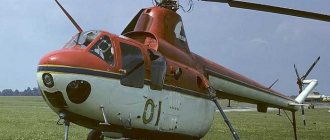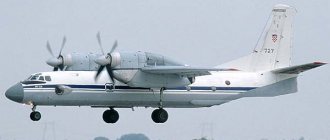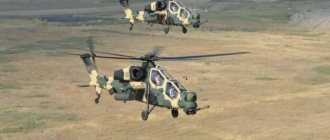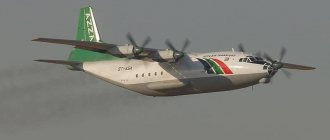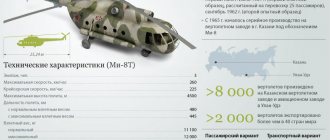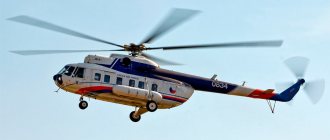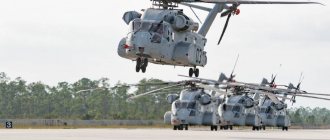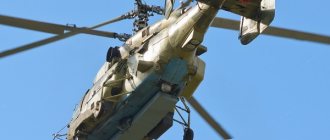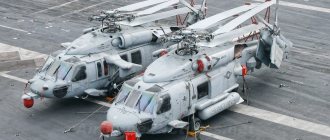The helicopter production plant in Kazan is the oldest enterprise of this type in Russia. Since the 50s, the production of such machines as the Mi-1 and Mi-4 has been mastered here. However, for a long time in Kazan they only assembled aircraft developed at the Mil and Kamov design bureaus.
This situation changed in the 90s. After the collapse of the Soviet Union, the Kazan plant, which became a joint-stock company, decided to independently develop new machines and promote them to the international market. And already in 1993, he presented the Ansat helicopter project, which translated from Tatar means “simple”.
History of creation and description of the design
By the 90s, the only Soviet multi-purpose light helicopter was the Mi-2, developed back in the early 60s and no longer able to compete with modern machines. Research conducted by specialists from the Kazan plant confirmed that a modern aircraft of this type will be in demand on the market.
The Ansat model, built in 1997, aroused interest even at the international air show in Le Bourget. This confirmed the correctness of the path chosen by KVZ. In the summer of 1999, the Ansat prototype made its first flight lasting 20 minutes. Certification of the aircraft was completed in 2011.
The Ansat helicopter is built according to a classic layout with one main rotor and a tail rotor on the tail boom.
The fuselage is all-metal, the propeller blades are made of fiberglass. Despite the traditional layout, there was room for innovation. For example, the main rotor blades have composite hingeless fastenings. In addition, the machine initially has a fly-by-wire control system.
The helicopter is equipped with two Canadian PW207K gas turbine engines equipped with an electronic control system. Each engine has a single-stage centrifugal compressor, and single-stage high and low pressure turbines. The shaft power is 630 hp. It is planned, as part of the import substitution program, to replace the engines with domestic VK-800.
When a flight resembles a trip in a comfortable car
Ease of maintenance and a spacious interior, combined with a successful design, make Ansat an excellent option for passenger transportation. The helicopter can carry up to eight passengers.
The car received the right to commercial passenger transportation at the end of 2014. A year later, Ansat was certified in the VIP version. The spacious cabin can accommodate five passengers with particular comfort; there is also a wardrobe, a mini-bar and a full luggage compartment. This salon is distinguished not only by its functionality and comfort, but also by its special design. The interior of the car is the result of the joint work of designers, constructors and technologists.
Photo: Alexander Utkin
In 2022, at the MAKS air show, the VIP-new Ansat was presented - a model in the style of the Aurus brand. At the beginning of 2020, the Russian Helicopters holding received approval from the Federal Air Transport Agency to produce this new premium version. The Ansat Aurus design project was carried out by specialists from Federal State Unitary Enterprise NAMI, the developer and manufacturer of luxury Aurus cars. However, the Ansat with an Aurus-style interior is not only distinguished by its premium interior. Thanks to the improved vibration damping and noise insulation system, the flight reminds passengers of a trip in a comfortable car.
Modifications
The spacious Ansat cargo compartment allows you to obtain options for various purposes through simple conversion. First of all, the helicopter is designed as a cargo or passenger helicopter. The version with a luxury cabin can be used for administrative transportation. The rescue and ambulance helicopters were certified.
For training, the Air Force developed a training version of the Ansat-U, characterized by a control system with quadruple redundancy and a non-retractable wheeled chassis.
This modification can not only be used for training purposes - such a feature as the ability to quickly retrofit is retained.
In 2005, at the air show, the original combat modification “Ansat 2RC” was presented, outwardly similar to the American “Cobra” and different from the basic version, just as the “Cobra” was different from the “Iroquois”. The Ansat assault aircraft received a two-seater tandem-type cabin, armed with a 12.7 mm Kord machine gun and units of unguided missiles. In addition, the production of a “simplified” modification, equipped with a traditional hydromechanical control system instead of a fly-by-wire control system, has been mastered.
KETSYKHI SVEAMN-RPEMKHPPNBNVMSHI BEPRNKER «yuMYARYu-s» YANGDYUM MU AYUGE KETSINTSN LMNTSNZHEKEBNTSN BEPRNKERYU “YUMYUR” (“OPNYARNI” ON-RYURYUPYAYKH). bEPRNKER PYUGPYUANRYUM y. A. yYUGYUMAYNTSN BEPRNKERMNTSN GUBNDU, BOEPBSHE ONDMJKYA B BNGDSU B 2005 TsNDS.
kETSYKHI BEPRNKER "YUMYUR-s" OPEDMYUGMYUVEM DK NASVEMKH YSPYUMRNB KERMSHU SVHKKHY KH ONDTSNRNBYKH KERMN-KHMYARPSYRNPAYNTSN YANYARYUBYU. OPH NAMYUYEMHH BEPRNKERYU NOZHHNMMSHL NANPSDNBYUMHEL NM LNFER OPHLEMRREYA DK PEYEMKH RPYUMYONPRMN-DEYUMRMSHU GYUDYUV, OEPEBNGYKH DN 9 VEKNBEY X DN 1300 YC TsPSGNB BMS RPH TCHGEKFYU, SHBUYYUZHKH PYUMEMSHU KH ANKEMSHU, NAEEAOEVEMKH TEKEDZETSEPYAYNI KH DPSTSKHU BHDNB YABGKH, BKHGSYUKEMNI BNGDSMNI PUGBEDYKH, OYURPSKHPPNBYUMKH OPNRЪFEMMSHU SVYUYARINB CPYUMHZH, LYUTSKHYARPYUKEY, NAEEAOEVEMH OYUPYUCHRMSHU OPSHFINB, BSHONKMEMKH ONKHYAYINBN-YAOYUYUREKEMSHU PYUANR.
nRKHVHREKEMSHLH YNMYARPSYRKHBMSHLH NYNAEMMNYARLH BEPRNKERYU ЪБКЪЧРЯЪ ШКеРПНДХЯРУМжХНММУЪ YAKHYARELYU SOPYUBKEMKH (shdyas), KHLECHYU VERSHPE SPNBBM PEGEPB KhPNBYUMKH. ANPRNBNE NANPSDNBYUMHE ONGBNKJER SHYHOYUFS B YANYARYUBE NDMNTsN HKKH DBSU OKHKNRNB SHYYAOXYURKHPNBURE BEPRNKER ON OPYUBHKYUL BHGSYUKEMNTSN ONKERYU (both) B KCHANE BPEL YASRNY KH B YAK NFMSHU LERENSYAKNBKHU.
BEPRNKER "YUMYAYUR-s" PYUGPYUANRYUM YNMYARPSYRNPYAYHL AChPN yYUGYUMAYNTSN BEPRNKERMNTSN GYUBNDU ON YKYUYAYAHVEYAYNI NDMNBKHMRNBNI YAUELE I PSKEBSHL BKHMRNL, I DBSL TSYUGNRSPAHMM SHLH DBHTSUREKLH. dK SDNAYARBU NASVEMKH KERMNTSN YANYARYUBY bbya Fri BEPRNKER NAMYUYEM YNKEYAMSHL YUYAYAH.
b YNMYARPSYZHKH BEPRNKERYU OPHLEMEMYU YAREIKNOKYYARKHYNBUYU AEYYUPMKHPMYU BRSKYU MEYASYYETSN BKHMRYU I SOPSTSKHLH PEYANPYULH-RNPYAHNMYULH, NRKHVYUCHYYUYYYUDEFMNYARECH, X GMNYANYARNIYNYARECH X KETSINYARECH B SOPYUBKEMXX. b YABNEL YKYUYAYAE BEPRNKER HLEER YAYULSHI ANKENNI NAZEL TCHGEKFYU √ 8.6 YB. L.
tsNYASDYUPYARBEMMSHE HYAOSHRYUMKH BEPRNKERYU "yuMYAYUR-s" GYUBEPHKHKYAE B 2008 TsNDS. Since 2009 TsNDYu BEPRNKER OPNKHGBNDHRYA YEPKHIMN H ONYARYUBKERYA B YUBHYUZHNMMSHI SVEAMSHY ZHEMRP lHMHYAREPYARBU NANPNMSH PNYAYAHH.
“YUMYAYUR-s” HYAONKEGSERYA YUY SWEAMYU LYUHMY DK bbya pNYAYAHH, RUYFE LNFER OPHLEMREYA DK NASVEMH OKHKNRNB YUBHYUZHHH KHMSHU BEDNLYARB.
mu DYUMMSHI LNLEMR PNYAYAHYYAYHE bbya ONKSVHKH SFE ME LEMEE 25 LYUHM RHOYU "YUMYUR-s", EYE 15 RYUHU LYUKHM ONYARSOKHR DN 2022 TsNDYu.
bePRNKERSH AYUGNBNTSN RHOYU "YUMYUR" HYAONKEGSCHRYA RUYFE YUBKHYUZHHEI tyaa, lbd RYURYUPYARYUMYU, MEINRNPSHLH YNLLEPVEYAYHLH YARPSYRSPYULH. YaELE BEPRNKERNB B 2004-2005 TsNDYUU GUYSOKHKYU chFMYU ynPE DK KEYAMSHU YAKSFA X ONKHZHHH. cru:
| lNDHTHYUZHH | YuMYaUR-s |
| dHYULERP TSKYUBMNTSN BKHMRYU, L | 11.50 |
| dHYULERP UBNYARNBNTSN BKHMRYU, L | |
| dKHMYu,L | 13.54 |
| bSHYANRYU,L | 3.56 |
| OSYARNCN | |
| LYUYAHLYUKEMYU BGKERMYU | 3300 |
| RHO DBKHTSUREK | 2 engines Pratt Whitney PK207K |
| lnymnyare, YbR | 2 U 463 |
| LYUYAKHLYUKEMYU YAYNPNYARE, YL/V | 275 |
| yPEIYEPYAYU YAYNPNYARE, YL/V | 220 |
| oPUYRHVEYAYU DUKEMNYARE, YL | 520 |
| YAYNPNONDZELMNYARE, L/LHM | 1290 |
| oPUYIRKHVEYAYKHI ONRNNKNY, L | 5500 |
| YaRYURKHVEYAYKHI ONRNNKNY, L | 3200 |
| ShYKHOYUF, VEK | 1-2 |
| ONKEGMYU MYUTSPSGYU: | DN 8 OYYAYUFKHPNB KHKH 1184 YC TsPSGYU |
| bottom. KhMTNPLYUZHKH: |
| tNRNCPYUTHH: | yMLYUR-s (c) yMRNM oERPNB |
| YuYAYUR-s (c) pSYAKYUM DEMKHYANB | |
| YuMYaUR-s (c) TsPKhTsNPKHI ъAKHM | |
| yuMYAYUR-s (c) yaEPCEI yNOZHEB | |
| yUAHMYU OKNRNB yuMYAYUR-s (c) EBTSEMKHI KEAEDEB |
| YaOHYANY HYARNVMKHYNB: |
| yun "ybg" . kETSYKHI SWEAAMN-RPEMKHPPNBNVMSHY BEPRNKER “YUMYYUR-s” BEPRNKERSH pNYAYAHH. KETSYKHI SVEAMN-RPEMKHPPNBNVMSHI BEPRNKER “YUMYYUR-s” Russianplanes.net. yuMYAYUR-s |
sTSNKNY MEAYU. 2015
Exploitation
Soon after the start of mass production, the Ansat turned out to be one of the most popular KVZ vehicles. By 2022, the Russian Air Force had received more than 40 Ansat-U training machines, and the medical version of the helicopter aroused particular interest among civilian buyers.
The first sanitary Ansats were received by the Tatar Ministry of Health. Then the new car was mastered in Kostroma. It was reported that thanks to the new medical Ansats, it was possible to increase the number of sorties. The Kazan “turntable” also became interested abroad – in 2022, a contract was signed for supplies to China.
"Air ambulance" for the country
A serious incentive for the promotion of Ansat on the Russian market was the state program for the development of air ambulances. According to this program, Ansat medical helicopters will be supplied to Russian regions along with the Mi-8/17. Compared to G8s, Ansat has a number of advantages - it can be used in urban environments, lands on small sites, and is more economical. In addition, the Ansata specialized medical module is of particular value.
Traditionally, a helicopter is considered a means of quickly delivering a victim to a medical facility with first aid on board, but its capabilities are usually limited. The Ansat medical module is capable of a full range of resuscitation procedures right in the air, which makes it possible not to miss that very “golden hour” after an incident.
Photo: Anton Tushin
The first Ansat with a medical module was transferred to the Ministry of Health of the Republic of Tatarstan at the end of 2016. To date, Russian customers have received more than 90 Ansat helicopters, of which about 40 machines are participating in the Russian air ambulance development program. Helicopters are already rescuing people in various regions of the country, including the Moscow region.
Last year, the Ansat sanitary service significantly expanded its capabilities. In March 2022, the medical module of the helicopter was supplemented with an incubator for transporting newborns. Another of the latest updates is an infectious disease box that allows you to safely transport patients with COVID-19.
Flight performance
The analogue closest in parameters to Ansat is usually called the European EC-145. Let's compare their main characteristics.
| "Ansat" | EC-145 | |
| Main rotor diameter, m | 11,5 | 11 |
| Length, m | 13,5 | 13 |
| Maximum take-off weight, t | 3,6 | 3,5 |
| Cruising speed, km/h | 250 | 246 |
| Practical range, km | 510 | 680 |
| Load capacity, t | 1,3 | 1,7 |
So, the “pinwheel” from Tatarstan is somewhat inferior to its analogue in terms of carrying capacity, which can be associated with the use of less powerful engines at the same weight. In general, the machines can be considered equivalent.
"Ansat" became a great achievement of the Kazan plant.
The newly formed design bureau, in a difficult economic situation, was able to create a modern, competitive helicopter “from scratch.” It is likely that new achievements will follow.
"Ansat-M": the flight continues
Ansat continues to improve, update, and increase the service life of a number of systems. For example, in 2022, the installation of an emergency splashdown system was certified, and approval was given for a major change to increase the airworthiness limitations of a number of the main helicopter components. This makes Ansat even more attractive to customers.
Despite the demand for the vehicle, industry experts point to a limitation that could hinder Ansat’s further commercial promotion abroad – its short flight range. In its basic version with a range of up to 505 km, Ansat is inferior to imported vehicles in its class. While such a range is quite sufficient for air ambulances, the helicopter may not be able to withstand competition in foreign markets for commercial transportation. Taking this into account, KVZ presented an Ansat-M modernization project back in November 2022. Then the chief designer of the plant, Alexei Garipov, announced that the range would increase to 604 km, and take-off weight to 3,800 kg.
Photo: Russian Helicopters
The first Ansat-M prototype with the declared characteristics took to the skies on December 29, 2022, flying 800 km. This was made possible thanks to the modernized fuel system. In addition, Ansat-M received the latest on-board electronics, which allows it to fly in zero visibility conditions. The weight of the helicopter was reduced by increasing the proportion of composite materials in the structure to 35%. Work is currently underway to create new steering and main rotor blades with improved aerodynamics. They will not only improve technical performance, but also make the flight more silent for passengers.
In 2022, the car is planned to be equipped with a new anti-icing system. As previously reported, the first customer for the helicopters will be Polar Airlines. Therefore, Ansat-M is preparing to become a real northern machine, ready for harsh conditions.
